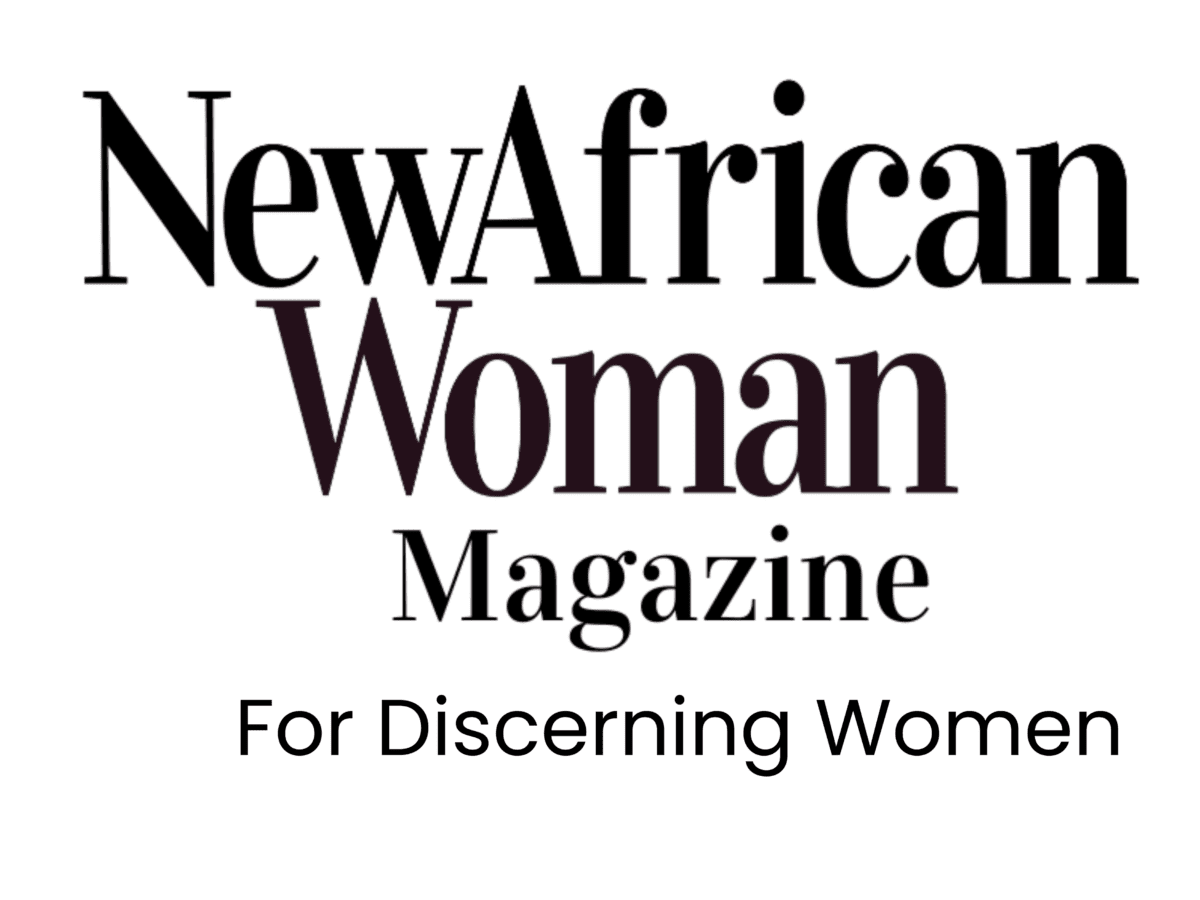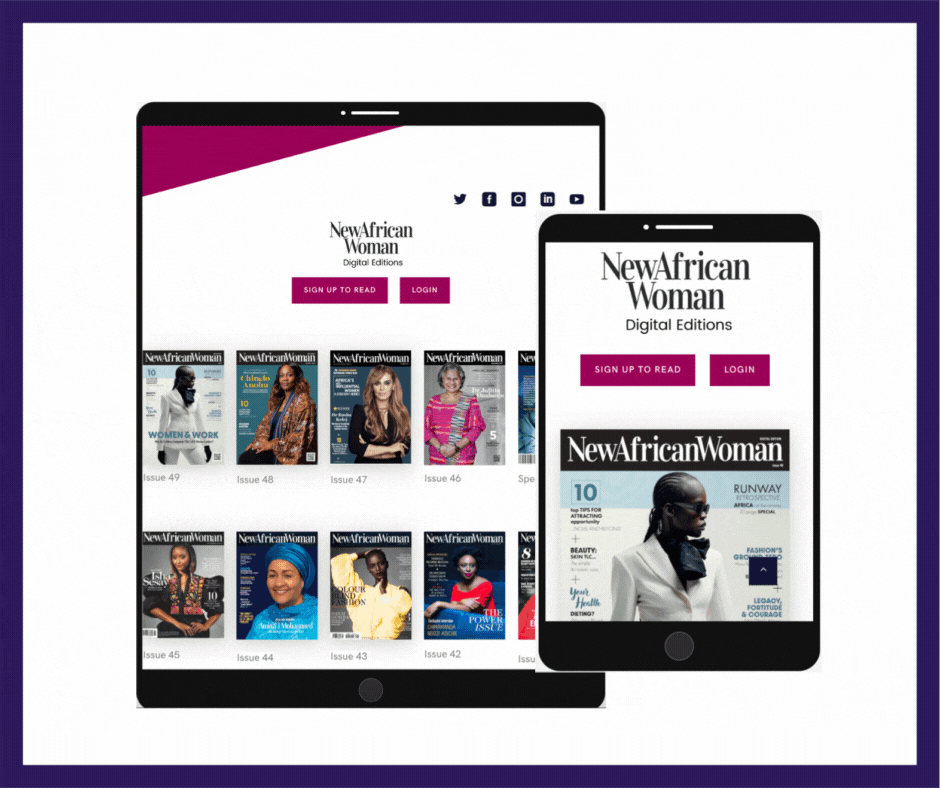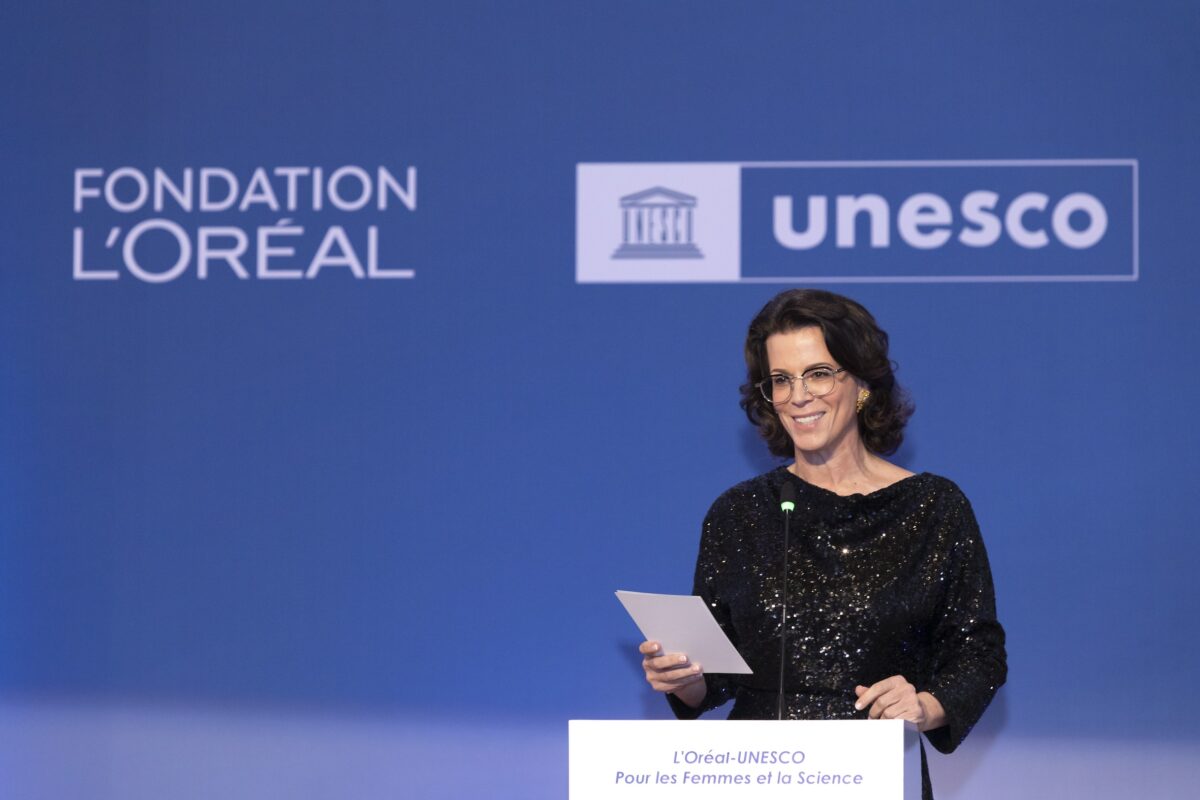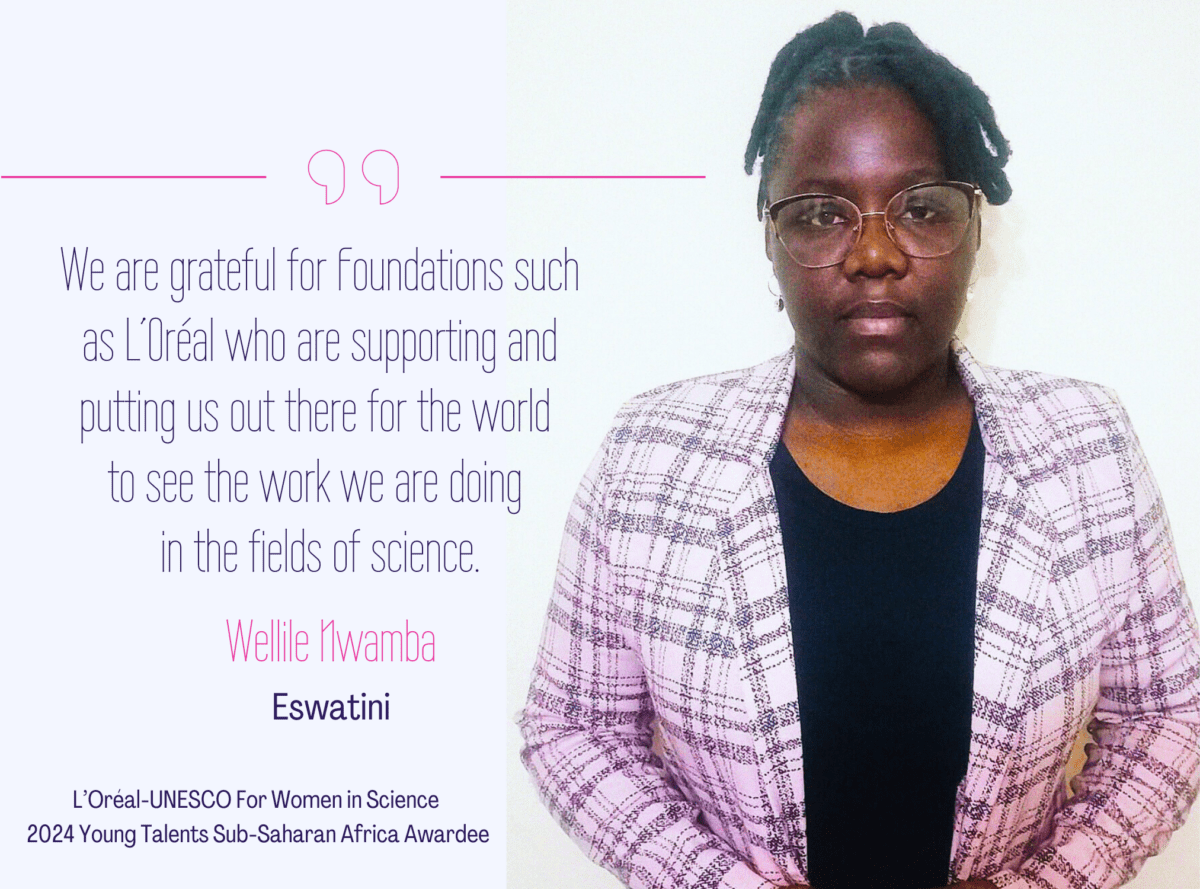Spotlight: L’Oréal-UNESCO For Women in Science Young Talents Sub-Saharan Africa 2024 Awardees (Longread)

Editor - NAW
Although gender diversity and inclusion in science, especially among the youth remain topical and relevant issues when discussing inequality in the field, programmes such as L’Oréal-UNESCO For Women in Science walk the talk – empowering and supporting young African talents historically underrepresented in the sciences. Welcome to its class of 2024.
Science and innovation are indisputably key drivers in any country’s economic development. In Sub-Saharan Africa, a new generation of women scientists is pioneering much-needed groundbreaking research, despite the many odds stuck against them.
The unveiling of this year’s 30 L’Oréal-UNESCO For Women in Science Young Talents Sub-Saharan Africa awardees on 10 December (in Cotonou -Benin) has therefore, been eagerly welcomed.
In its 15th year, the L’Oréal-UNESCO For Women in Science Young Talents Sub-Saharan Africa Awards celebrates and supports African women scientists for the quality of their scientific research.
The 2024 cohort drew 25 PhD candidates and 5 post-doctoral researchers from 15 African countries, following a rigorous selection process which attracted 800 entries from East, West, Central and Southern regions of Africa.
Rewarded for their innovative work and commitment to addressing major scientific challenges that threaten the continent, this year’s young talents work across various disciplines including climate change, agriculture, Artificial Intelligence, astronomy, healthcare, technology, biodiversity conservation and much more.
The breadth of the collation not only reflected their innovative flare and unwavering commitment to their respective fields but also their resilience and tenacity in a not-so-level playing field for females.
Women represent only 31.5% of researchers In Sub-Saharan Africa. For this reason, the Fondation L’Oréal and UNESCO joined forces 15 years ago to spotlight and support the scientific excellence the young scientists offer, and to encourage more women to take up careers in science.
The 2024 cohort reflects the scientists’ innovative flare, but also their tenacity in a not-so-level playing field for females.
Since its founding, L’Oréal-UNESCO For Women in Science Young Talents Sub-Saharan Africa program has recognized 240 young researchers from more than 34 African countries and received over 4,000 applications. Those who have been awarded, have benefited not only from financial support, including research grants of €10,000 for PhD candidates and €15,000 for post-doctoral researchers, but also with training in leadership and communication.
“The challenges awaiting the world and the African continent are significant. Yet, we are merely at their threshold. To address those challenges, we need science more than ever. However, women who wish to pursue scientific careers are battling headwinds of obstacles [even though] they can bring adapted perspectives, boundless innovative capabilities, and unwavering commitment to everyone’s development,” decries Alexandra Palt, Vice President of the Fondation L’Oréal.
A view largely echoed by the majority of the young talent awardees themselves.
For example, Ellasy Gulule – a Doctoral student in Earth Sciences at the University of Malawi, who is empowering farmers to better plan for climate change and governmental officials to provide appropriate support – believes that while some progress is being made in supporting female scientists in Africa, a lot more needs to be done:
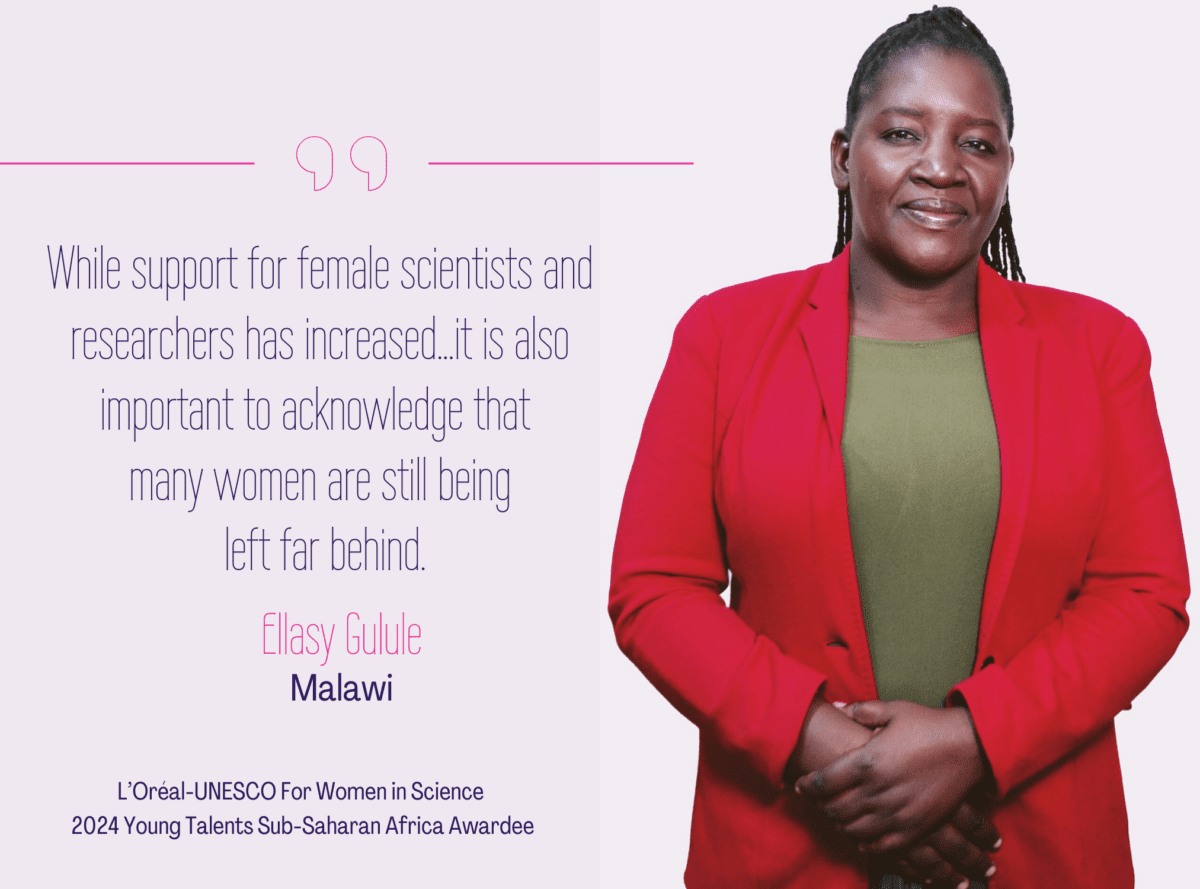
“While support for female scientists and researchers has increased, and the trends are there, with some deliberate efforts being put in place, it is also important to acknowledge that gaps are still there. Many women are still being left far behind, she tells NewAfricanWoman.
“I will give you an example. I am a lecturer at Malawi University of Science, Technology and Maths, where I teach Earth Sciences. In one of my classes, there is no woman, and in the other, there are only four. So it is not just a question of supporting female scientists to be up there, but we have to ask, how many girls are we taking along for sciences at the primary school level? How many are studying sciences at the secondary school level?” she questions while explaining further.
The answer is that by the time we are talking about female scientists studying at college or university, many would have already been left behind. To get more girls into sciences at primary level is therefore one of my other passions.”
Need for funding
Passion is also what drives Welile Nwamba. Her research into using a urine sample test to detect tuberculosis (TB) found outside the lungs – or extrapulmonary tuberculosis (EPTB), has the potential of revolutionising the speed of diagnosis and therefore saving many lives.
Although EPTB accounts for about 15 to 20% of cases globally, Africa has the greater burden because of the higher rates of HIV infection, with reports suggesting that TB outside the lungs accounts for up to 30% of cases in Sub-Saharan Africa. This simple and rapid test can help to detect the disease earlier. A much-needed solution particularly in regions with limited medical resources. Welile’s research therefore, is pioneering.
She explains to us: “You know TB is generally known as the disease of the lungs. My focus in this research is TB outside the lungs, like TB of the heart, lymphatic TB, or spinal TB. [the latter which can present as back pain]. So, while we can test for TB of the lungs using sputum, how would we do so for TB of the heart, which would mean we would have to get into the heart to get a sample. But can we afford it in Africa with our limited resources, particularly at the primary healthcare service level? Do we have the expertise? These are some of the challenges and limitations and in the meantime, the disease is not parking away waiting for solutions. This is why I am passionate about this research.”
Without delving too much into the science behind her research, she briefly explains: “When fragments from a molecule called LAM (Lipoarabinomannan) which is the wall of the TB bacteria itself, are excreted into the bloodstream, they can excrete into the urine… and that is where we try to catch it [EPTB ]. The only sample that we need is urine. It is not invasive, it’s not painful and like a pregnancy test it would be easy to do, the results are quick, and therefore, this research will go a long way in helping diagnose, treat and contain the disease at primary healthcare level. But this type of research needs money. This is why we are so grateful for Foundations such as L’Oréal who are supporting and putting us out there, for the world to see our work and our contributions in the fields of science.”
However, the Eswatini native decries the lack of broader support for young scientists, including in her own country: “I think my country still has a lot of work to do. But it’s not just in Eswatini where as women, we still need our voices, work and contributions supported and amplified.”
Sustainable Solutions
As Africa experiences one of the world’s highest population growth rates, currently counting a population of 1.5 billion, (expected to reach 2.5 billion by 2050 and over 4 billion by 2100), this signifies significant challenges, particularly in the face of climate disruptions that exacerbate droughts and contaminate soils which directly threaten the continent’s populations’ food security.
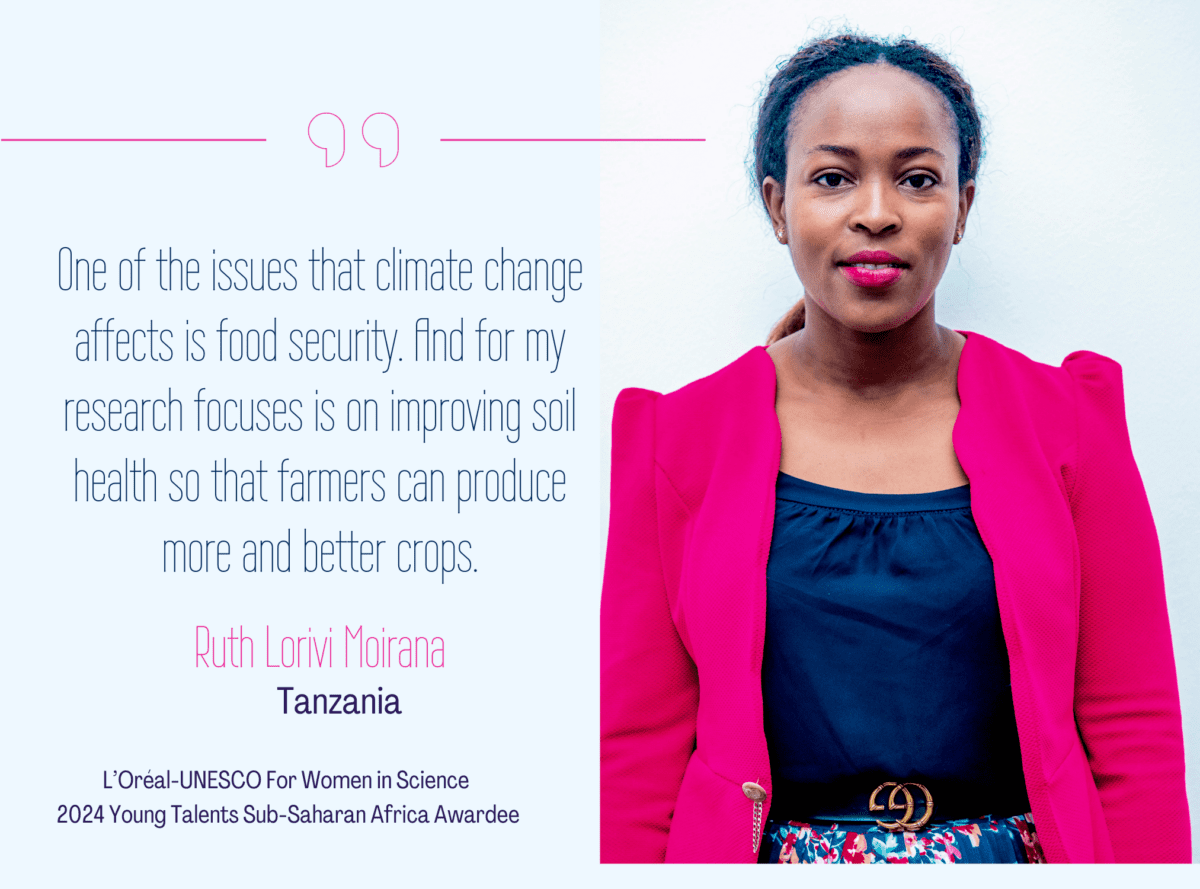
Like her peer Ellasy, Tanzanian awardee Ruth Lorivi Moirana, a post-doctoral student in Material Science at the Nelson Mandela African Institution of Science and Technology, is breaking ground by formulating a novel organic fertilizer composite, “to help provide crops with sufficient nutrients and improve soil health while protecting against erosion and chemical leaching.”
In the face of climate change, this research can help build resilience, provide for higher agricultural yields and help stem food insecurity.
“One of the issues that climate change affects is food security. And for my research focuses is on improving soil health so that farmers can produce more and better crops,” Ruth tells us.
“We have all these soils that are contaminated, either naturally or through pollutants due to human activity and therefore, they cannot really be used for [healthy and productive] agriculture. Why? Because if the soil is contaminated and you plant in it, the roots will take those contaminants and accumulate them into the edible parts of the plant. So when people eat [unknowingly] they are eating those contaminants and this affects people’s health too.” she explains with concern.
The issue With Fluoride
But that is not all! Chemical contamination alters the soil chemistry, which in turn changes its responsiveness to traditional fertilisers, thereby impacting the availability of plant nutrients.
“The presence of these contaminants in the soil reacts with the fertilizers…for example, the presence of fluoride. Fluoride is a very active contaminant. It reacts and halts the nutrients from going into the plants. So no matter how much the amount of fertiliser a farmer puts in their plants, the nutrients are not taken by the plant, and this leads to poor food productivity. It is therefore important to neutralise these contaminants and that is why I am passionate about the success of this research,” she explains.
However, appealing directly to her government, she adds: “I understand the importance of fertilisers which the country currently uses. But I want my government to understand that they cannot be used in all types of soils. For example, phosphate fertilisers already contain 2-3 percent of fluoride in it. So, it does not help to use a fertiliser like this in already contaminated soils. So, while the use of the fertilisers can be good, the authorities should look out for what my research calls outlier soils which need a fertiliser specially designed for them.”
But also, of further concern to her, is how soil contaminants like fluoride have had a direct impact on the health of some populations in her country. “In parts of northern Tanzania where the concentration of fluoride in the soil is very high – naturally by the way, you find a lot of people there suffer from Skeletal fluorosis,” she says.
Skeletal fluorosis is a bone disease that occurs when someone consumes too much fluoride over a long period. It can cause bone weakness, pain, stiffness, and deformities.
“One of the major contributors to the disease in that part of the country is the food people eat, which contains fluoride…what we want to do is to design treatment plans for these soils, for example with methods that improve soil health and give the soil the ability to fight the contaminants…that’s one way.”
Such an ingenious idea requires all the support it can get, and apart from the one she is getting through Fondation L’Oréal and UNESCO, Ruth also hopes her own government can see the importance of getting on board to develop further and scale up this problem-solving research.
Combating NCDs
The proliferation of non-communicable and neglected diseases in Africa is undeniable, and so is the need for new and innovative solutions to help combat them. Science is, therefore, always presenting unique and needed opportunities.
This is certainly the case for Benin’s Marie-Marthe Chabi, a doctoral student in Biological Sciences at the University of Abomey-Calavi in Cotonou.
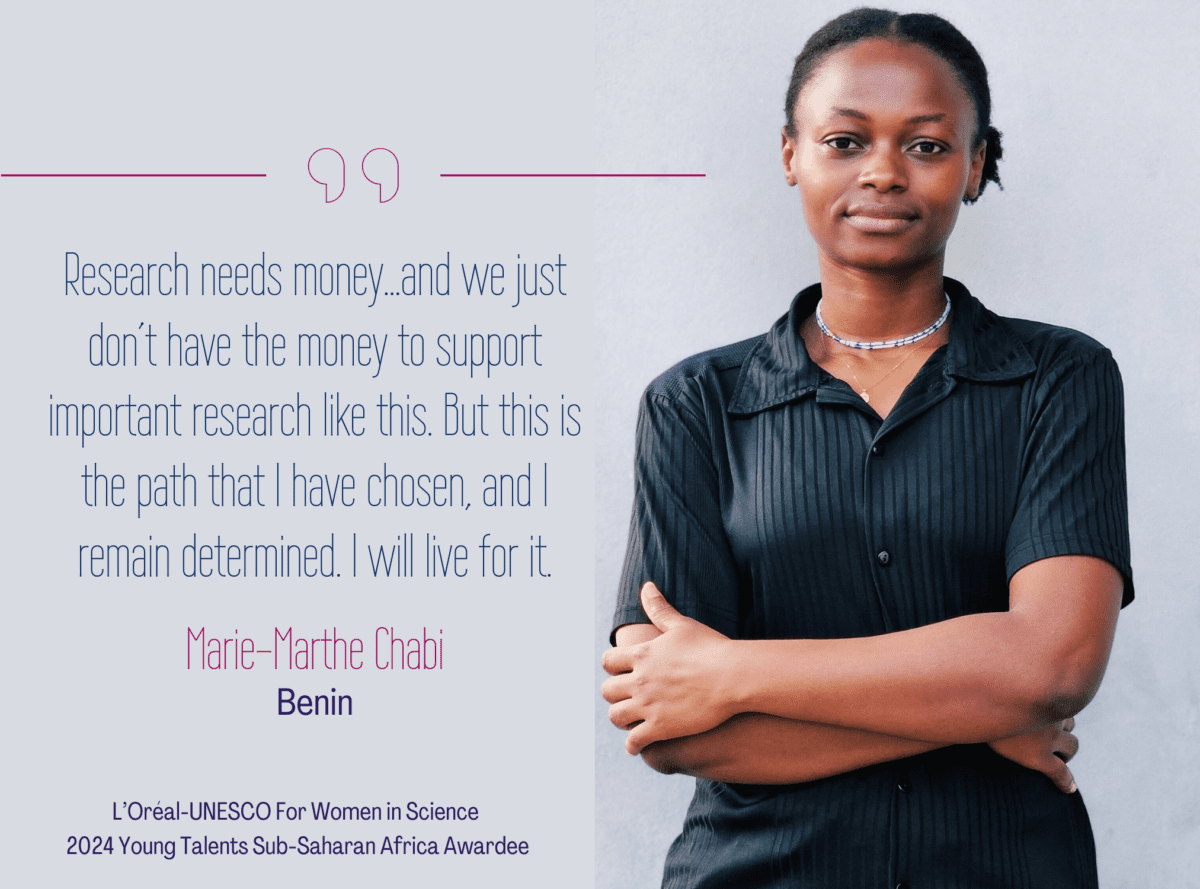
With the prevalence of diabetes in Sub-Saharan Africa expected to rise from 23.5 to 54.9 million people by 2045, Marie-Marthe’s primary area of research is type 2 diabetes (T2DM) – a metabolic disease often called a silent killer in Africa because it routinely goes undiagnosed for many of those who suffer from it.
According to a recent Global Burden of Disease Study, published in The Lancet, the age-standardised prevalence of diabetes in sub-Saharan Africa rose by 83% between 1990 and 2021, reaching 4248 cases per 100 000 individuals, and projections predict a 57% increase in diabetes in sub-Saharan Africa by 2050, reaching a prevalence of 6688 cases per 100 000 individuals. A worrisome picture which could entail a public health crisis.
But even where the diagnosis is done, proper care for T2DM patients can often luck. Marie-Marthe’s innovative research into improving the quality of life in diabetes patients is therefore timely and pertinent.
“My research explores the effects of red light and near-infrared light as a way to induce an antioxidant response in patients, reduce the burden of inflammation and help normalise blood sugar levels. Most type 2 diabetic patients suffer from the effects of long-term inflammation, for example, eye problems [retinopathy] damage to the nerves [neuropathy] and cardiovascular disease,’ she enlightens us.
She adds: “The light stimulates energy production within mitochondria, the small powerhouses within cells, leading to increased consumption of glucose. This would help to prevent these risks and reduce the consequences of the disease for example preventing amputations or loss of vision.”
However, Marie-Marthe is also quick to add that research and projects like hers require funding and time. As such, she is collaborating with a research lab in Paris for her vision.
“But my ambition is to bring this research home to make it more effective, but unfortunately research needs money…and here we just don’t have the money to support important research like this. But this is the path that I have chosen, and I remain determined. I will live for it,” she states with firm resolve.
No woman should die giving life
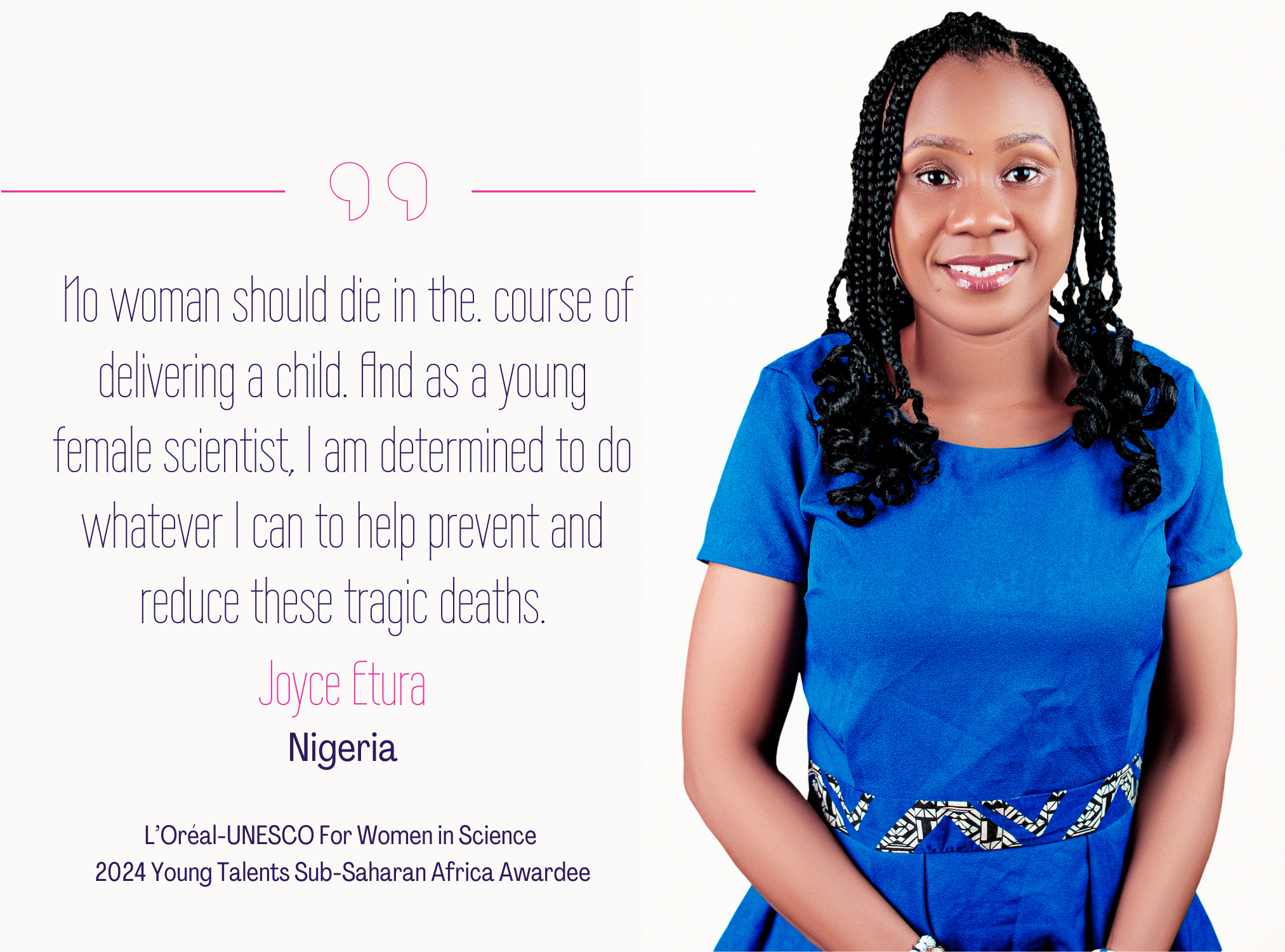
Joyce Etura, a doctoral student in Medical Sciences at the University of Calabar in Nigeria, was inspired to do her research on improving maternal health due to a personal tragedy.
“My cousin died of preeclampsia,” she shares. Preeclampsia is a hypertensive disorder that can affect both the mother and child during pregnancy and after giving birth. It’s a leading cause of illness and death for both the mother and baby, according to the WHO.
“No woman should die in the course of delivering a child. And as a young female scientist, I am determined to do whatever I can to help prevent and reduce these tragic deaths,” she says with emphatic zeal.
Her research focuses on the early detection and prevention of preeclampsia through biomarkers, by harnessing technological innovations such as wearable monitors with a focus on the placenta, considering factors such as age and ethnicity which is a novel approach in her country Nigeria.
She explains: “In Africa, especially Nigeria where I come from, many women take healthy pregnancies for granted, and this can often lead to preventable deaths during childbirth. For example, those who choose to go to their traditional birth attendants, or their churches for delivering their babies.
She adds: “As a young female scientist, I have chosen the field of maternal health to help educate and sensitise women on the importance of professional care during pregnancy and delivery because traditional and religious attendants are not always qualified.”
“I am very determined to succeed in helping reduce maternal and infant mortality in my country and as such, I am committed to overcoming the obstacles that I face as a female scientist. I will run with it to the end.”
Plant Power
Female role models play a significant part in inspiring the next generation in any field – but more so in the world of science. For Ethiopia’s Melat Cherenet, that role model came in the name of the globally renowned Ethiopian physiologist and pharmacologist Prof. Yalemtsehay Mekonnen, who was the first woman to become the country’s professor.
A doctoral student in Biological Sciences at Addis Ababa University, Melat first met Prof. Yalemtsehay Mekonnen in 2014. “Meeting her was my first entry point because I was very fascinated with her work in medicinal plants,” she recalls.
Fast-forward 2024, and with the support of her mentor and role model, Melat is a L’Oréal-UNESCO For Women in Science Young Talents awardee for her research on the use of medicinal plants in helping to treat illnesses caused by helminths (parasitic worms), more specifically, she is investigating roundworm and hookworm parasites, which are widely prevalent in the soils of Ethiopia and tropical regions of Africa. The larvae of these worms can penetrate the human body, and can affect the nerves, eyes, skin, intestines and other organs. And with drug resistance ever posing a challenge to treatment, this research promises to be a gamechanger too.
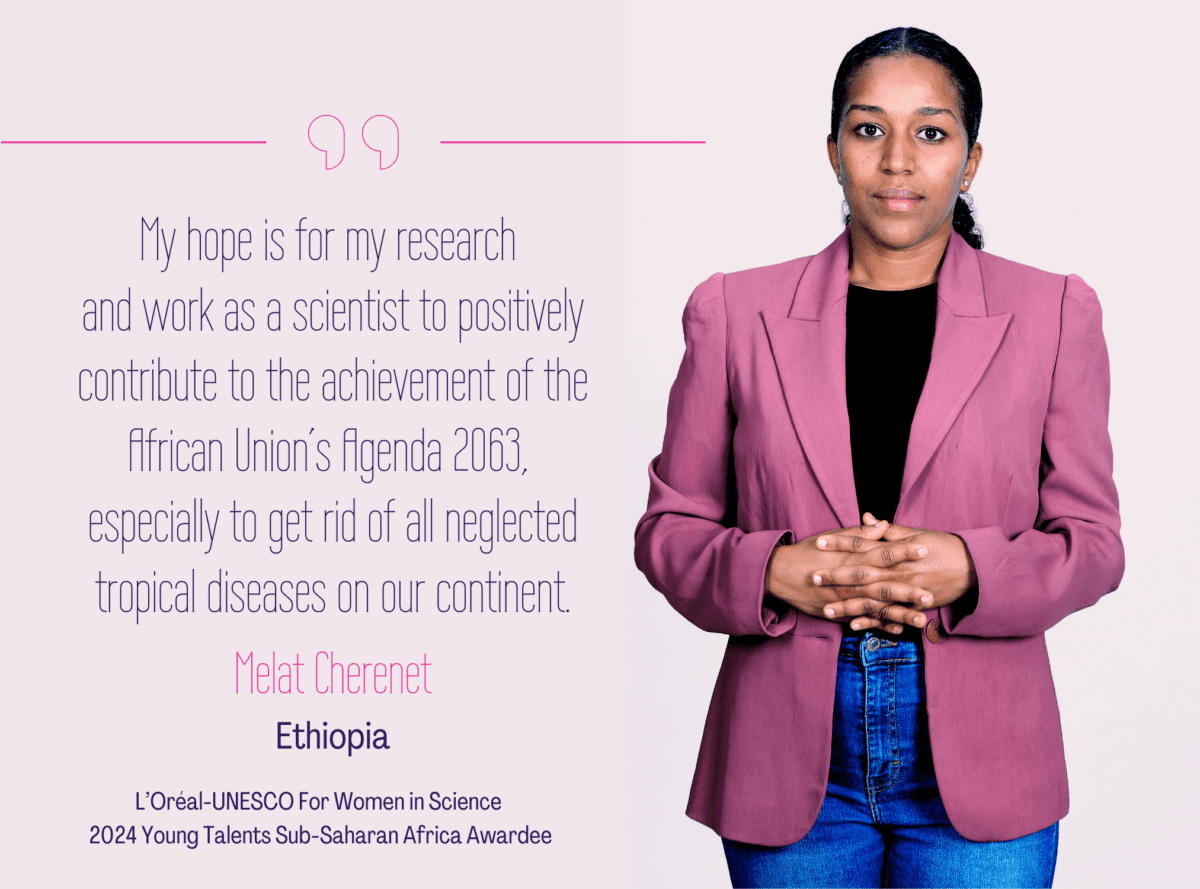
“For my project, I am working with plants which are widely used in different parts of Ethiopia in traditional medicine to treat different ailments. However, although these plants are used widely, their use is not supported by scientific research. So, I am working on determining the efficacy of medicinal plants using different helminths species and models, to understand their efficacy on the symptoms. And if my research goes well, the aim is to find compounds from these plants, which can be used to produce a new drug. This is important considering the fall in the efficacy of the current drugs in treating helminth species. Hopefully, my research will also solve the issue of drug resistance,” Melat tells NewAfricanWoman.
Looking to the future
Where does she see herself and the future of her research in the next 5 years? “My hope is for my research and my work as a scientist to positively contribute to the achievement of the African Union’s agenda 2063, especially to get rid of all neglected tropical diseases on our continent. I also personally hope to see traditional medicine sold side by side with modern medicines in pharmacies, as alternative options. This is a way forward in my view and I hope that I will one day have products which are supported by scientific studies, have fewer side effects, but are accessible to many people with a lesser price tag.”
Exuding confidence and a positive demeanour Malet concludes: “Although it is challenging to do scientific research in Africa because of the lack of funding, I think am doing well. And I am determined to do well,” she tells us.
Greatest Potential
“One of the greatest strengths and potential of the African continent is youth. For young people, science presents a unique opportunity… Science-based education and training programmes equip youth with the tools necessary to thrive in a rapidly evolving world,” proffers Lidia Brito, UNESCO’s Assistant Director-General for Natural Sciences.
Indeed, despite Africa’s surmountable challenges, what is clear is that the contribution of African women scientists is key to resolving them. And if the calibre of L’Oréal-UNESCO For Women in Science Young Talents Sub-Saharan Africa 2024 awardees was a yardstick, many solutions lie with them, and many other home-grown female scientists in Africa.
